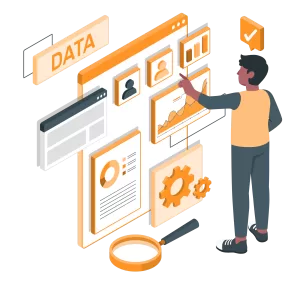In the age of information overload, simply having data is no longer enough. For businesses aiming to drive impact, what matters is not just what the data says—but how it’s communicated. Enter data storytelling, a powerful technique that transforms raw numbers into compelling narratives that engage, inform, and inspire action.
What Is Data Storytelling?
Data storytelling is the craft of taking raw data and turning it into a compelling narrative that uncovers insights, context, and meaning in a way that speaks to the audience. It uses three main elements—data, story, and visuals—to explain not only what the numbers are but why they are important.
Data is the basis, but the story allows people to see the connections, making it easier to understand trends, causes, and effects. Visuals like charts, graphs, or infographics make them clearer and help to distill complex information.
Unlike presenting data or showing visuals, data storytelling combines emotion and logic together, appealing to both the thinking and feeling brain.
This method makes insights more memorable, compelling, and actionable—allowing business leaders, analysts, and communicators to make decisions and drive outcomes effectively.
Why It Matters
1. It Enhances Understanding
Raw data can be hard to understand—even daunting. But a good story makes it easier, exposing trends and giving better context. Storytelling follows the natural way our brains work and remember things that make complex data simple, easy-to-understand insights.
2. It Inspires Action
Well-told stories engage the emotional centers of the brain. A graph will inform you that profits fell; a story will inform you why and what’s at stake, and leadership will move quickly.
3. It establishes trust
Putting facts into context makes decision-making simple to comprehend. This establishes trust among stakeholders, customers, and internal teams.
4. It Unites Teams
Stories bring together different jobs and levels of experience. A marketing manager, data analyst, and executive might interpret charts differently, but a story brings everybody together with a common understanding.

Types of Data Storytelling
1. Linear Storytelling
Linear data storytelling presents data in a straightforward, step-by-step manner—like a regular story. This approach leads the audience by the hand from beginning to end, so it’s ideal for illustrating cause-and-effect, timelines, or trends over time.
For example, a marketing analyst would use a linear story to illustrate how a campaign evolved and impacted sales week to week.
This format builds suspense and keeps the audience engaged because the story logically progresses to a conclusion or final observation. It’s best used for those who prefer being guided through a story with a clear format.
2. Non-linear or Interactive Storytelling
Non-linear storytelling allows the user to decide how to view the information. Rather than reading a single story, users can use interactive dashboards or visual reports and discover information of interest.
Non-linear storytelling is appropriate for complicated data with multiple views or conclusions. Users can interact with data in their own fashion through filters, drill-downs, or click-able charts.
It assists decision-makers to personalize their search and discover insights that are more specific to their own questions or requirements.
3. Comparing Stories
Comparative storytelling compares different datasets, time periods, or groups to make meaningful conclusions. Comparative storytelling is often used to present contrasts, track progress, or compare performance.
An organization can, for example, compare performance in different regions or compare results before and after a campaign. The strength of comparative storytelling is that it can present contrasts and trends that raise questions or make ideas.
By setting data points side by side, it makes it easy for the audience to quickly grasp contrasts, similarities, and underlying meanings.
4. Predictive Storytelling
Predictive storytelling applies history facts and analysis to predict future trends or developments. It combines data science techniques such as machine learning with storytelling to narrate what will happen and why.
For instance, a company can apply predictive storytelling to show that customer loss can increase unless something is done. Predictive storytelling is a forward strategy—it does not just tell us something about the future but prepares us for it.
By presenting future potential as a story, it makes predictive insights actionable and comprehensible to technical and non-technical individuals.
5. Character-driven Storytelling
Data is made more relatable through character-driven narrative by concentrating on actual people impacted by the data.
Rather than relying on purely abstract figures, it weaves a narrative of a customer, employee, or stakeholder and uses that narrative to extrapolate to the broader trends or conclusions.
For instance, recounting the story of an elderly customer who walked away due to poor service can make a figure in a customer satisfaction report become more tangible.
This type of storytelling injects emotional resonance and enables the audience to relate to the data, and therefore it is extremely powerful in user research, HR analytics, or customer experience presentations.
How to Craft a Story from Data
Step 1: Find the Insight
The first step in crafting a solid data story is to discover significant insights within the data. This is more than simply observing trends—it’s examining the information with a sense of curiosity and skepticism.
Look for patterns, outliers, or unexpected relationships that might teach you something valuable. Ask significant questions such as: What’s unexpected here? What’s unique here? What’s shifting over time? These insights are the foundation of your narrative.
They are the “hook” that engages the audience and makes them care. Without a solid insight, the story is empty and means nothing, so this process is critical to drive the story.
Step 2: Understand the Audience
Once you have your key point, then the next step is to determine who you are talking to. Your audience decides everything—down to words you choose and how much detail you provide and what type of pictures will resonate with them.
For instance, an executive in a corporation will likely crave big-picture points related to business outcomes whereas a technical team will crave detailed numbers. Consider your audience’s jobs, their objectives, their pain points, and what they already understand about the data.
The more your story conforms to what matters to them, the more engaging and effective it will be. Changing your message to conform to their perspective makes it relevant and understandable.
Step 3: Build the Narrative
Having context and understanding of the audience in mind, it is now time to frame your story. Like any good story, a data story needs to have a clear beginning, middle, and end. Start with the context or the background—why things are the way they are.
Second, present the conflict or the problem that your data shows, with evidence and imagery. Finally, move to the resolution by explaining what the insight is and why it is important.
Use storytelling mechanisms such as suspense, pacing, and emotional hints to sustain interest. Make it simple to comprehend and follow.
A well-framed story allows the audience to connect the dots and recall the message even when the data is no longer remembered.
Step 4: Visualize the Data
Graphics assist in conveying your story and making hard numbers more understandable. Good data visualization simplifies complicated information.
Select graphical types that are most useful to your message—bar charts for contrasts, line graphs for trends, heat maps for showing distributions, or pie charts for straightforward segments.
Don’t overdo and clutter the graphics and use clean and informative graphics that facilitate comprehension. Label key points clearly and use color, contrast, and layout to guide attention effectively.
Your graphics should not just tell the story but also guide the audience to easily navigate and interact with the data.
Step 5: Inspire Action
The ultimate purpose of a data story is not to provide access to information—it’s to inspire action. Your conclusion should provide the answer to the question: “What now?”
It may be a recommendation, a decision, or a shift in strategy, but the ultimate message needs to be one that can be acted upon and be suitable for the business landscape. Connect your call to action to the insight directly and validate it by facts to give it credibility.
Clarify the value of action and the cost of inaction. This step makes your story transform from merely reporting to an instrument to facilitate change. It’s where your story matters and proves its value.
Conclusion
Data storytelling is more than just a trend—it transforms the manner in which we connect, collaborate, and lead. With the conversion of numerals to narrative, companies enable people to comprehend, make data-driven decisions, and establish a culture of openness and curiosity.
Today’s world, in which people don’t have time to learn dashboards or read spreadsheets, is what differentiates good analysts from great leaders, the skill to tell a story.
The next time you are presenting information, rather than think “What does this information say?” think “What story does it want to tell?”


